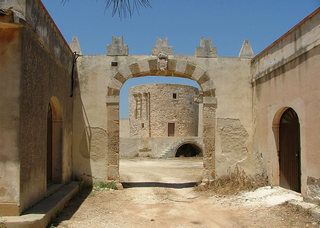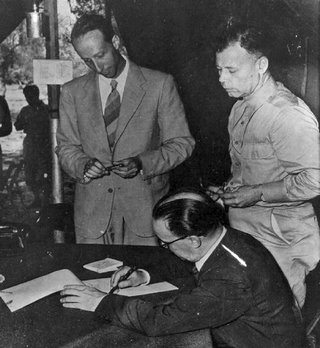3 Commando’s capture of the Italian strongpoint at Torre Cuba helped prepare the ground (literally) for the surrender of Italy and the signing of the Armistice.
Major Peter Young had a disappointing start to Operation Husky, the Allied invasion of Sicily on 10 July 1943. He was the commanding officer of half of 3 Commando, and he had been ordered to neutralise Italian defences on the shoulder of George Beach, prior to the main seaborne forces arriving. However he and his men spent the night in their landing craft shuttling from one wrong position to another. They finally arrived off George Beach after the assault waves had gone in and the beach had been captured. Already annoyed at missing the action, he was even more frustrated when his men were then given what was in effect a lowly garrisoning role, well behind the front lines.
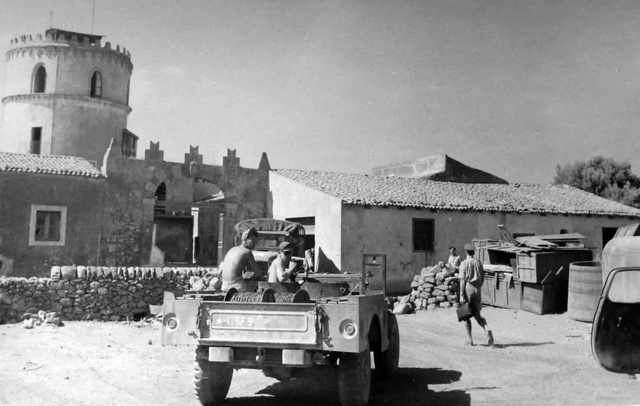
The main seaborne forces had pushed forwards to capture Syracuse as quickly as they could. Their job was to relieve the glider troops holding a key bridge, the Ponte Grande, and then to capture the town’s port facilities before the Italians could blow them up. These objectives were critical to the success of the entire invasion, so the leading troops only tackled obstacles that were in their way or which directly threatened the landings. This left several Italian strongpoints more or less unmolested.
The next day, much to Young’s satisfaction, part of 3 Commando was selected to deal with two such defensive posts. Young’s report describes what happened:
“On the morning of [11th] July, 1943, Lt-General DEMPSEY, Cmdr. XIII Corps, gave orders that a fighting patrol, from No 3 Commando, should clear the area between the road junction Torre Ognina and Cassibile. This mission was entrusted to 3 Troop under the command of Capt. J. N. de W. Lash. I accompanied this expedition as an observer. The Troop made very good speed from CASSIBILE to road and railway junction.“
The first objective on the list was a farm called Torre Cuba. Like many farms near the Sicilian coast, it had been fortified back in the days of the Barbary pirates, who constantly raided these shores (‘torre’ means ‘tower’). The tower allowed the enemy to be spotted offshore in good time, and crenellated walls allowed for defence.
Now Torre Cuba was being used for exactly the same purposes by the Italians, to fend off another seaborne invasion. The tower was used as an OP (observation post) by the spotter for a field gun battery further inland. The battery had been put out of action on D-Day by glider troops acting on their own initiative, which left only Torre Cuba’s role as a strongpoint. It was garrisoned by men of the 2nd Company of the Italian 430th Coastal Battalion under Captain Alfredo Covatta. Young continued:
“We received information from a R.A.S.C. Coy. that there had been firing from the direction of TORRE CUBA during the night, but that, as everything had been quiet that morning, they assumed that the enemy had withdrawn or surrendered. This was misleading, for when the Troop arrived close to this farm, they came under a well sustained fire from at least three Breda guns, not to mention riflemen. At this time Capt. Lash [was] with H.Q. and L/Sgt Knowland’s sub-section to the right of the road, Lt. Buswell to the left of the road, both within one hundred yards of the farm. I myself, with my runners, was advancing 200 yards from the farm, and Lt. Nicholas with his Section was somewhere to the right of the road.
“The engagement lasted for about 15 minutes and during most of that time I was busily engaged crawling backwards on my stomach, to get out of the line of fire of 2 of the aforementioned M.G.s. A point of detail as regards equipment to be improvised is some better method of carrying hand grenades than the present one of sticking them on the belt by lever. I, several times, had to crawl back for mine when I least wished to do so.
“Meanwhile, Capt. Lash approached the TORRE CUBA crawling up the right hand side of the wall bounding the road to the S.W. corner of the Farm where there was a concrete M.G. Post. Every time that he advanced, Lt. Herbet D.C.M. M.M. sprang up and plastered the Post with a Bren gun fired from the shoulder. While this was going on the party was sniped ineffectively from their right, from the direction of a glider which had crashed about 300 yards away. Capt. Lash threw a grenade at the M.G. Post but missed it; the gunners however ran away.
“Taking advantage of their momentary confusion, Capt. Lash, Lt. Herbet D.C.M. M.M., and Tpr. Underwood of Sgt. Knowland’s sub-section entered the farm followed by C.S.M. Fawcett. They wounded about 8 Italians and unfortunately one British parachutist who was a prisoner in the farm. A general surrender ensued. About the same time Lt. Buswell and L/Sgt. Shaw’s sub-section, which had advanced through an orchard under a fairly hot fire and without any hesitation, effected an entry on the north end of the farm. Tprs. Knill and Hough both showed dash in pushing on to the water tower on the sea side of the position, but resistance was at an end.
“A little before this, Tpr. Pritchard enabled my H.Q. and Lt. Nicholas’ section to advance without casualties by coming coolly back along the wall and indicating which line of approach was clear. In this attack 2 Officers and 51 O.R.s of the 206th Coastal (Italian) Division were taken prisoner, and 1 Officer and 10 other ranks of-the British Airborne Division were rescued.
“Tpr. Smith was our only casualty, he was wounded a little in rear of me by the first burst. As the prisoners were filing away to the rear, I singled out the Coy. Cmdr. Captain COVATTO and kept him with me. I should like to say that, in my opinion, good troops should hold this position until a cannon is brought against it. The farm was more or less square with strong walls and buildings around it, which were loop-holed. There was a Breda M.G. at each corner and another in the tower and trenches 12 feet deep inside the position.
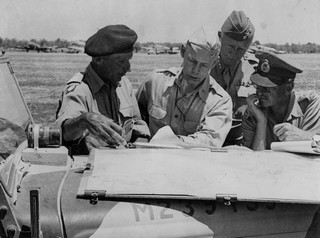
“The enemy had seen us approaching when we were 3/4 of a mile away through an excellent telescope on top of the water tower, which was about 60 feet high. They held their fire quite well. They had previously beaten off 3 smaller fighting patrols from a bridgehead and had captured the parachutists aforementioned. It is alleged that some of the Italian private soldiers said they would not have fought if Capt. Covatto had not forced them to do so. In my opinion, the credit for the capture of Torre Cuba must go to Capt. Lash, Lt. Herbet D.C.M. M.M, and Tpr. Underwood.
“The Airborne troops and a few men under C.S.M. Fawcett took the prisoners back to CASSIBILE. The remainder of the troop now advanced on Torre Ognina.”
Torre Ognina
Torre Ognina [map] was another centuries-old watch tower. It stood alone on the scrubby headland of Capo Ognina. Young thought his landing craft had probably been machine-gunned from here the day before while hunting for their landing spot. Young continued:
“On the way Capt. Covatto indicated to us a minefield at about (114210) [on the coast road] where we passed an evacuated Italian strong point. We then captured Torre Ognina without any resistance. The Garrison of 1 Officer and 16 other ranks surrendered when Capt. Covatto informed them that they would receive no quarter if they fired. The patrol then returned to CASSIBLE, with its prisoners, having examined two crashed gliders but found nobody to rescue.”
After these actions the men of 3 Commando were kept out of action in readiness for their next major mission. This took place two days later, when they were sent to seize a bridge near Lentini in support of the drive on Catania.
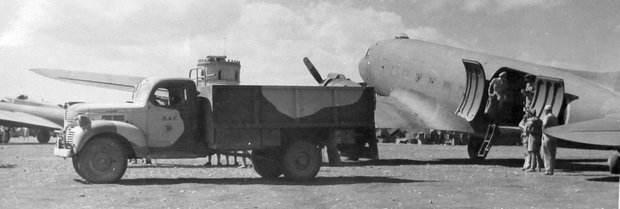
Cassibile Airfield
As for Torre Cuba, it became the air traffic control tower for a brand new airfield hurriedly constructed by the Allies. The area had been preselected from aerial photographs during planning in North Africa. Major Young may not have known it, but the need to get started on preparing the airfield may have lent urgency to his mission to Torre Cuba.
The nearest place on the map was Cassibile [map], so the airfield took the village’s name. At the northern end of the airfield a large camp, called Fairfield, was erected near the fortified manor house of San Michele [map] [photos]. The airfield and camp became a convenient headquarters hub. Senior generals would fly in in their personal planes, hold meetings, and then fly out again. Eisenhower and Montgomery both had B-17 Flying Fortress bombers.
Finally, on 3 September 1943, the Italians signed an armistice in a tent in Fairfield Camp. One of Winston Churchill’s fondest dreams thus came true – the invasion of Sicily had led to Italy being knocked out of the war.
.
With thanks to Lorenzo Bovi for permission to use his photo of Torre Cuba.

